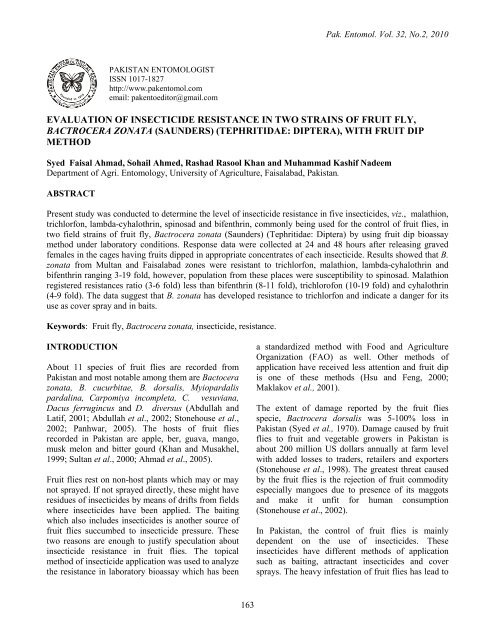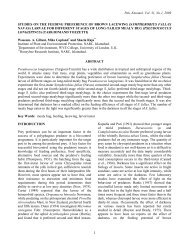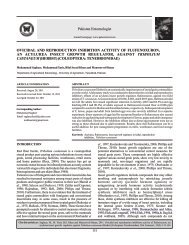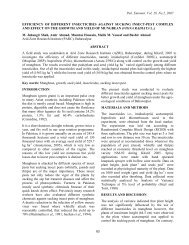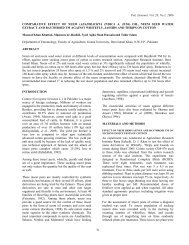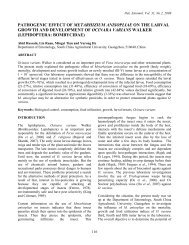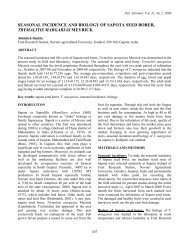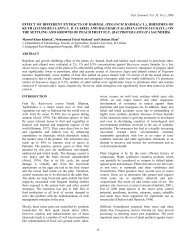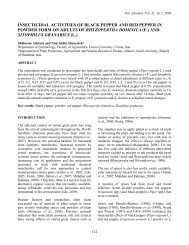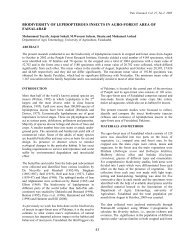evaluation of insecticide resistance in two strains of fruit fly ...
evaluation of insecticide resistance in two strains of fruit fly ...
evaluation of insecticide resistance in two strains of fruit fly ...
Create successful ePaper yourself
Turn your PDF publications into a flip-book with our unique Google optimized e-Paper software.
Pak. Entomol. Vol. 32, No.2, 2010<br />
PAKISTAN ENTOMOLOGIST<br />
ISSN 1017-1827<br />
http://www.pakentomol.com<br />
email: pakentoeditor@gmail.com<br />
EVALUATION OF INSECTICIDE RESISTANCE IN TWO STRAINS OF FRUIT FLY,<br />
BACTROCERA ZONATA (SAUNDERS) (TEPHRITIDAE: DIPTERA), WITH FRUIT DIP<br />
METHOD<br />
Syed Faisal Ahmad, Sohail Ahmed, Rashad Rasool Khan and Muhammad Kashif Nadeem<br />
Department <strong>of</strong> Agri. Entomology, University <strong>of</strong> Agriculture, Faisalabad, Pakistan.<br />
ABSTRACT<br />
Present study was conducted to determ<strong>in</strong>e the level <strong>of</strong> <strong><strong>in</strong>secticide</strong> <strong>resistance</strong> <strong>in</strong> five <strong><strong>in</strong>secticide</strong>s, viz., malathion,<br />
trichlorfon, lambda-cyhalothr<strong>in</strong>, sp<strong>in</strong>osad and bifenthr<strong>in</strong>, commonly be<strong>in</strong>g used for the control <strong>of</strong> <strong>fruit</strong> flies, <strong>in</strong><br />
<strong>two</strong> field stra<strong>in</strong>s <strong>of</strong> <strong>fruit</strong> <strong>fly</strong>, Bactrocera zonata (Saunders) (Tephritidae: Diptera) by us<strong>in</strong>g <strong>fruit</strong> dip bioassay<br />
method under laboratory conditions. Response data were collected at 24 and 48 hours after releas<strong>in</strong>g graved<br />
females <strong>in</strong> the cages hav<strong>in</strong>g <strong>fruit</strong>s dipped <strong>in</strong> appropriate concentrates <strong>of</strong> each <strong><strong>in</strong>secticide</strong>. Results showed that B.<br />
zonata from Multan and Faisalabad zones were resistant to trichlorfon, malathion, lambda-cyhalothr<strong>in</strong> and<br />
bifenthr<strong>in</strong> rang<strong>in</strong>g 3-19 fold, however, population from these places were susceptibility to sp<strong>in</strong>osad. Malathion<br />
registered <strong>resistance</strong>s ratio (3-6 fold) less than bifenthr<strong>in</strong> (8-11 fold), trichlor<strong>of</strong>on (10-19 fold) and cyhalothr<strong>in</strong><br />
(4-9 fold). The data suggest that B. zonata has developed <strong>resistance</strong> to trichlorfon and <strong>in</strong>dicate a danger for its<br />
use as cover spray and <strong>in</strong> baits.<br />
Keywords: Fruit <strong>fly</strong>, Bactrocera zonata, <strong><strong>in</strong>secticide</strong>, <strong>resistance</strong>.<br />
INTRODUCTION<br />
About 11 species <strong>of</strong> <strong>fruit</strong> flies are recorded from<br />
Pakistan and most notable among them are Bactocera<br />
zonata, B. cucurbitae, B. dorsalis, Myiopardalis<br />
pardal<strong>in</strong>a, Carpomiya <strong>in</strong>completa, C. vesuviana,<br />
Dacus ferrug<strong>in</strong>cus and D. diversus (Abdullah and<br />
Latif, 2001; Abdullah et al., 2002; Stonehouse et al.,<br />
2002; Panhwar, 2005). The hosts <strong>of</strong> <strong>fruit</strong> flies<br />
recorded <strong>in</strong> Pakistan are apple, ber, guava, mango,<br />
musk melon and bitter gourd (Khan and Musakhel,<br />
1999; Sultan et al., 2000; Ahmad et al., 2005).<br />
Fruit flies rest on non-host plants which may or may<br />
not sprayed. If not sprayed directly, these might have<br />
residues <strong>of</strong> <strong><strong>in</strong>secticide</strong>s by means <strong>of</strong> drifts from fields<br />
where <strong><strong>in</strong>secticide</strong>s have been applied. The bait<strong>in</strong>g<br />
which also <strong>in</strong>cludes <strong><strong>in</strong>secticide</strong>s is another source <strong>of</strong><br />
<strong>fruit</strong> flies succumbed to <strong><strong>in</strong>secticide</strong> pressure. These<br />
<strong>two</strong> reasons are enough to justify speculation about<br />
<strong><strong>in</strong>secticide</strong> <strong>resistance</strong> <strong>in</strong> <strong>fruit</strong> flies. The topical<br />
method <strong>of</strong> <strong><strong>in</strong>secticide</strong> application was used to analyze<br />
the <strong>resistance</strong> <strong>in</strong> laboratory bioassay which has been<br />
a standardized method with Food and Agriculture<br />
Organization (FAO) as well. Other methods <strong>of</strong><br />
application have received less attention and <strong>fruit</strong> dip<br />
is one <strong>of</strong> these methods (Hsu and Feng, 2000;<br />
Maklakov et al., 2001).<br />
The extent <strong>of</strong> damage reported by the <strong>fruit</strong> flies<br />
specie, Bactrocera dorsalis was 5-100% loss <strong>in</strong><br />
Pakistan (Syed et al., 1970). Damage caused by <strong>fruit</strong><br />
flies to <strong>fruit</strong> and vegetable growers <strong>in</strong> Pakistan is<br />
about 200 million US dollars annually at farm level<br />
with added losses to traders, retailers and exporters<br />
(Stonehouse et al., 1998). The greatest threat caused<br />
by the <strong>fruit</strong> flies is the rejection <strong>of</strong> <strong>fruit</strong> commodity<br />
especially mangoes due to presence <strong>of</strong> its maggots<br />
and make it unfit for human consumption<br />
(Stonehouse et al., 2002).<br />
In Pakistan, the control <strong>of</strong> <strong>fruit</strong> flies is ma<strong>in</strong>ly<br />
dependent on the use <strong>of</strong> <strong><strong>in</strong>secticide</strong>s. These<br />
<strong><strong>in</strong>secticide</strong>s have different methods <strong>of</strong> application<br />
such as bait<strong>in</strong>g, attractant <strong><strong>in</strong>secticide</strong>s and cover<br />
sprays. The heavy <strong>in</strong>festation <strong>of</strong> <strong>fruit</strong> flies has lead to<br />
163
Pak. Entomol. Vol. 32, No.2, 2010<br />
the use <strong>of</strong> cover sprays (Anonymous, 1986). The<br />
<strong><strong>in</strong>secticide</strong>s, for example, organophosphates,<br />
carbamates, synthetic pyrethroids and new chemistry<br />
are be<strong>in</strong>g <strong>in</strong>discrim<strong>in</strong>ately used by farmers as cover<br />
sprays (Stonehouse et al., 1997; Alston, 2002;<br />
Ahmad et al., 2005; El-Aw et al., 2008). In this<br />
paper, we have determ<strong>in</strong>ed <strong>resistance</strong> <strong>in</strong> some<br />
populations <strong>of</strong> B. zonata collected from Multan and<br />
Faisalabad and compared with a laboratory reared<br />
population aga<strong>in</strong>st bifenthr<strong>in</strong> (Talstar 10 EC),<br />
trichlorfon (Diptrex 80 SP), lambda-cyhalothr<strong>in</strong>e<br />
(Karate 2.5 EC), Malathion (Fyfanon 57 EC) and<br />
sp<strong>in</strong>osad (Tracer 240 SC).<br />
MATERIALS AND METHODS<br />
Present study was conducted under laboratory<br />
conditions (28 o C, 55±5% RH) <strong>in</strong> Department <strong>of</strong> Agri.<br />
Entomology, University <strong>of</strong> Agriculture, Faisalabad to<br />
determ<strong>in</strong>e the level <strong>of</strong> <strong>resistance</strong> aga<strong>in</strong>st five<br />
<strong><strong>in</strong>secticide</strong>s aga<strong>in</strong>st <strong>fruit</strong> <strong>fly</strong>, B. zonata (Saunders)<br />
commonly used for its control. Field populations <strong>of</strong><br />
B. zonata from Faisalabad and Multan zone were<br />
collected from the <strong>in</strong>fested and fallen <strong>fruit</strong>s <strong>of</strong> the<br />
mangoes and guava. A reference susceptible stra<strong>in</strong><br />
was obta<strong>in</strong>ed from CABI, Multan <strong>in</strong> pupal form<br />
which has been reared for the last many years without<br />
<strong><strong>in</strong>secticide</strong> exposure for comparison. The experiment<br />
was laid down accord<strong>in</strong>g to completely randomized<br />
design with three replicates <strong>in</strong>clud<strong>in</strong>g an untreated<br />
control. Rear<strong>in</strong>g <strong>of</strong> both susceptible and field stra<strong>in</strong>s<br />
<strong>of</strong> B. zonata were carried <strong>in</strong> Perspex cages on healthy<br />
mango <strong>fruit</strong>s for egg lay<strong>in</strong>g. The <strong>in</strong>fested <strong>fruit</strong>s were<br />
then placed <strong>in</strong> a wooden cage hav<strong>in</strong>g soil at the<br />
bottom for pupation. The pupae were isolated from<br />
the soil and placed <strong>in</strong> a separate cage for emergence.<br />
The adults were fed on banana based artificial diet<br />
hav<strong>in</strong>g <strong>in</strong>gredients such as egg yolk, sugar, honey,<br />
yeast, syrup vitam<strong>in</strong> B complex blended <strong>in</strong> the ratio<br />
<strong>of</strong> 2:4:8:2:2:1 respectively <strong>in</strong> an electric blender to<br />
make a paste and was kept <strong>in</strong> a freezer for subsequent<br />
use.<br />
Commercial formulations <strong>of</strong> tested <strong><strong>in</strong>secticide</strong>s were<br />
obta<strong>in</strong>ed from their manufacturers and were used<br />
after their dilutions <strong>in</strong> distilled water for the<br />
determ<strong>in</strong>ation <strong>of</strong> level <strong>of</strong> <strong>resistance</strong> aga<strong>in</strong>st field<br />
populations <strong>of</strong> B. zonata. 5-6 serial concentrations <strong>of</strong><br />
each <strong><strong>in</strong>secticide</strong> were made to obta<strong>in</strong> most practical<br />
concentration that yielded mortality between 5-95%<br />
<strong>in</strong> each case. Fruit dip bioassay method was used to<br />
expose both susceptible and field stra<strong>in</strong>s <strong>of</strong> B. zonata<br />
aga<strong>in</strong>st <strong><strong>in</strong>secticide</strong>s. Fresh mangoes were dipped <strong>in</strong><br />
the <strong><strong>in</strong>secticide</strong> solution for 2-3 seconds and then were<br />
air dried. Treated <strong>fruit</strong>s were placed <strong>in</strong> the plastic jars<br />
and equal numbers <strong>of</strong> 12-15 days old female adults<br />
were transferred to each jar where they were also<br />
provided with the normal adult diet. The open<strong>in</strong>gs <strong>of</strong><br />
the plastic jars were covered with musl<strong>in</strong> cloth <strong>in</strong><br />
order to prevent escape <strong>of</strong> flies and also for proper<br />
aeration. Irreversible knockdown followed by death<br />
<strong>of</strong> the adult <strong>fruit</strong> flies was the criterion to determ<strong>in</strong>e<br />
mortality at the <strong>in</strong>tervals <strong>of</strong> 24 and 48 hours.<br />
Data for adult mortality were subjected to Probit<br />
Analysis and was corrected by Abbott’s formula<br />
(Abbott, 1925) and analyzed by Probit Analysis<br />
(F<strong>in</strong>ney, 1971) us<strong>in</strong>g the s<strong>of</strong>tware POLO-PC (LeOra<br />
S<strong>of</strong>tware, 1987). The LC 50 values <strong>of</strong> each compound<br />
were estimated and compared with that <strong>of</strong> the<br />
laboratory stra<strong>in</strong> to determ<strong>in</strong>e the ratio <strong>of</strong> <strong><strong>in</strong>secticide</strong><br />
<strong>resistance</strong>.<br />
RESULTS<br />
Response <strong>of</strong> B. zonata stra<strong>in</strong>s aga<strong>in</strong>st bifenthr<strong>in</strong><br />
LC 50 (ppm) <strong>of</strong> bifenthr<strong>in</strong> aga<strong>in</strong>st Faisalabad<br />
population was 458.62 at 24 hrs which was reduced<br />
to 247.77 after 48 hrs. In susceptible stra<strong>in</strong> the value<br />
<strong>of</strong> LC 50 was found to be 55.79 and 25.2 ppm after 24<br />
and 48 hrs, respectively. Thus, Faisalabad stra<strong>in</strong><br />
exhibited the <strong>resistance</strong> ratio <strong>of</strong> 8 folds after 24 hrs<br />
with an <strong>in</strong>crease up to 9.8 folds after 48 hrs. In<br />
Multan stra<strong>in</strong>, LC 50 <strong>of</strong> bifenthr<strong>in</strong> was found to be<br />
533.33 and 279.28 ppm at 24 and 48 hrs,<br />
respectively, with the <strong>resistance</strong> ratio <strong>of</strong> 11 folds<br />
(Table 1).<br />
Response <strong>of</strong> B. zonata stra<strong>in</strong>s aga<strong>in</strong>st trichlorfon<br />
Faisalabad stra<strong>in</strong> was found to be 10 and 13 folds<br />
more resistant as compared to the susceptible stra<strong>in</strong><br />
with the LC 50 (ppm) <strong>of</strong> 133.33 and 61.93 at 24 and 48<br />
hr respectively <strong>in</strong> comparison to that <strong>of</strong> susceptible<br />
stra<strong>in</strong> 12.79 and 4.75 at 24 and 48 hrs, respectively<br />
(Table 2). Multan stra<strong>in</strong> was found more resistant (6-<br />
9) to trichlor<strong>of</strong>on with the LC 50 values <strong>of</strong> 214.45 and<br />
93.67 ppm at 24 and 48 hrs, respectively (Table 2).<br />
Response <strong>of</strong> B. zonata stra<strong>in</strong>s aga<strong>in</strong>st malathion<br />
LC 50 (ppm) for Faisalabad stra<strong>in</strong>, respectively, were<br />
60.81 and 24.96 ppm at 24 and 48 hrs (Table 3) with<br />
low <strong>resistance</strong> ratio <strong>of</strong> 3 folds.<br />
164
Pak. Entomol. Vol. 32, No.2, 2010<br />
Table 1. LC 50 and Fit <strong>of</strong> Probit l<strong>in</strong>es <strong>in</strong> stra<strong>in</strong>s <strong>of</strong> B. zonata aga<strong>in</strong>st bifenthr<strong>in</strong>.<br />
Stra<strong>in</strong>s<br />
Observation LC 50<br />
CI<br />
Fit <strong>of</strong> Probit l<strong>in</strong>e<br />
(hrs ) (ppm) (95%) Slope±SE λ 2 RR<br />
Laboratory<br />
24 55.79 39.16-91.63 1.41±0.27 0.38 -<br />
48 25.2 18.17-33.55 1.9±0.31 1.29 -<br />
Faisalabad<br />
24 458.62 305.89-852.04 1.21±0.26 0.22 8.22<br />
48 247.77 172.93-345 1.72±0.31 1.12 9.83<br />
Multan<br />
24 533.33 367.8-950.23 1.38±0.27 0.90 9.55<br />
48 279.28 168.78-331.91 1.76±0.31 0.96 11.08<br />
CI= Confidence <strong>in</strong>terval; RR= Resistance ratio; LC 50 = Lethal concentration.<br />
Table 2.-LC 50 and Fit <strong>of</strong> Probit l<strong>in</strong>es <strong>in</strong> stra<strong>in</strong>s <strong>of</strong> B. zonata aga<strong>in</strong>st trichlorfon.<br />
Stra<strong>in</strong>s<br />
Observation LC 50 CI<br />
Fit <strong>of</strong> Probit l<strong>in</strong>e<br />
(hrs ) (ppm) (95%) Slope±SE λ 2 RR<br />
Laboratory<br />
24 12.79 8.86-21.11 1.34±0.27 0.52 -<br />
48 4.75 3.34-6.27 1.98±0.33 2.92 -<br />
Faisalabad<br />
24 133.33 91.95-237.56 1.38±0.27 0.90 10.42<br />
48 61.93 42.86-86.83 1.68±0.31 0.91 13.03<br />
Multan<br />
24 214.45 151.67-343.31 1.44±0.27 0.20 16.76<br />
48 93.67 64.84-127.33 1.73±0.30 0.84 19.72<br />
CI= Confidence <strong>in</strong>terval; RR= Resistance ratio; LC 50 = Lethal concentration.<br />
Table 3. LC 50 and Fit <strong>of</strong> Probit l<strong>in</strong>es <strong>in</strong> various stra<strong>in</strong>s <strong>of</strong> B. zonata aga<strong>in</strong>st malathion.<br />
Stra<strong>in</strong>s<br />
Observation LC 50<br />
CI<br />
Fit <strong>of</strong> Probit l<strong>in</strong>e<br />
(hrs ) (ppm) (95%) Slope±SE λ 2 RR<br />
Laboratory<br />
24 16.66 11.49-29.69 1.38±0.27 0.90 -<br />
48 7.74 5.4-7.78 1.72±0.31 1.12 -<br />
Faisalabad<br />
24 60.81 41.94-106.4 1.35±0.27 0.17 3.65<br />
48 24.96 16.93-34.45 1.71±0.31 0.99 3.22<br />
Multan<br />
24 91.68 64.35-142.98 1.4±0.27 0.10 5.50<br />
48 48.17 33.46-65.7 1.73±0.30 0.97 6.22<br />
CI= Confidence <strong>in</strong>terval; RR= Resistance ratio; LC 50 = Lethal concentration.<br />
Table 4. LC 50 and Fit <strong>of</strong> Probit l<strong>in</strong>es <strong>in</strong> stra<strong>in</strong>s <strong>of</strong> B. zonata aga<strong>in</strong>st lambda-cyhalothr<strong>in</strong>.<br />
Stra<strong>in</strong>s<br />
Observation LC 50<br />
CI<br />
Fit <strong>of</strong> Probit L<strong>in</strong>e<br />
(hrs ) (ppm) (95%) Slope±SE λ 2 RR<br />
Laboratory<br />
24 53.61 37.91-85.82 1.44±0.27 0.20 -<br />
48 17.49 7.72-28.38 2.00±0.33 3.36 -<br />
Faisalabad<br />
24 229.97 161.47-380.43 1.42±0.27 0.21 4.28<br />
48 84.91 61.88-110.1 2.28±0.37 1.99 4.85<br />
Multan<br />
24 422.44 229.84-703.39 1.35±0.27 0.56 7.87<br />
48 162.13 113.84-214.50 1.42±0.27 2.87 9.26<br />
CI= Confidence <strong>in</strong>terval; RR= Resistance ratio; LC 50 = Lethal concentration.<br />
165
Pak. Entomol. Vol. 32, No.2, 2010<br />
Table 5. LC 50 and Fit <strong>of</strong> Probit l<strong>in</strong>es <strong>in</strong> stra<strong>in</strong>s <strong>of</strong> B. zonata aga<strong>in</strong>st sp<strong>in</strong>osad.<br />
Stra<strong>in</strong>s<br />
Observation LC 50 CI<br />
Fit <strong>of</strong> Probit L<strong>in</strong>e<br />
(hrs ) (ppm) (95%) Slope±SE λ 2 RR<br />
Laboratory<br />
24 53.61 37.91-85.82 1.44±0.27 0.20 -<br />
48 19.89 13.92-26.6 1.87±0.31 0.87 -<br />
Faisalabad<br />
24 41.73 28.85-65.02 1.35±0.26 0.23 0.77<br />
48 21.61 15.48-28.35 2.14±0.35 2.5 1.08<br />
Multan<br />
24 87.45 59.46-141.86 1.28±0.26 0.76 1.63<br />
48 36.96 26.51-41.08 2.28±0.37 1.29 1.85<br />
CI= Confidence <strong>in</strong>terval; RR= Resistance ratio; LC 50 = Lethal concentration.<br />
LC 50 for the Multan stra<strong>in</strong> was 91.68 ppm at 24 hrs<br />
which was decreased to 48.17 ppm after 48 hrs <strong>of</strong><br />
exposure with <strong>resistance</strong> ratio <strong>of</strong> 5 and 6 fold,<br />
respectively.<br />
Response <strong>of</strong> B. zonata stra<strong>in</strong>s aga<strong>in</strong>st lambdacyhalothr<strong>in</strong><br />
LC 50 (ppm) for lambda-cyhalothr<strong>in</strong> was 53.61 and<br />
17.49 at 24 and 48 hrs with RR <strong>of</strong> 4 folds. LC 50 <strong>of</strong><br />
422.44 (7 folds) and 162.13 (9 folds) ppm was<br />
recorded <strong>in</strong> Multan stra<strong>in</strong> (Table 4).<br />
Response <strong>of</strong> B. zonata stra<strong>in</strong>s aga<strong>in</strong>st sp<strong>in</strong>osad<br />
Both the field populations <strong>of</strong> B. zonata were found<br />
highly susceptible to sp<strong>in</strong>osad (Table 5). After the<br />
exposure <strong>of</strong> 24 hrs, <strong>resistance</strong> ratio <strong>in</strong> Faisalabad<br />
stra<strong>in</strong> was found to be 0.77, which <strong>in</strong>creased to 1.08<br />
after 48 hrs present<strong>in</strong>g susceptibility with the LC 50<br />
(ppm) <strong>of</strong> 41.73 and 21.61 after 24 and 48 hrs,<br />
respectively, whereas, Multan stra<strong>in</strong> exhibited the<br />
<strong>resistance</strong> ratio <strong>of</strong> 1 both after 24 and 48 hrs, and also<br />
showed susceptibility towards sp<strong>in</strong>osad with the LC 50<br />
<strong>of</strong> 87.85 and 36.96 ppm <strong>in</strong> comparison to that <strong>of</strong><br />
susceptible stra<strong>in</strong> (53.61 and 19.89 ppm after 24 and<br />
48 hrs, respectively).<br />
DISCUSSION<br />
From the results it is evident that both the field<br />
stra<strong>in</strong>s exhibit vary<strong>in</strong>g ratios <strong>of</strong> <strong><strong>in</strong>secticide</strong> <strong>resistance</strong><br />
aga<strong>in</strong>st <strong><strong>in</strong>secticide</strong>s <strong>in</strong> the order <strong>of</strong> trichlor<strong>of</strong>on <<br />
bifenthr<strong>in</strong> < lambda-cyhalothr<strong>in</strong>e < Malathion <<br />
sp<strong>in</strong>osad. Both the field stra<strong>in</strong>s showed high degree<br />
<strong>of</strong> susceptibility towards sp<strong>in</strong>osad. Hsu and Feng<br />
(2000) assayed B. dorsalis adults and found<br />
trichlorfon to be the least effective among the five<br />
<strong><strong>in</strong>secticide</strong>s tested. Our results are also <strong>in</strong> l<strong>in</strong>e to that<br />
<strong>of</strong> Kashyap and Hameed, 1982, but contradictory to<br />
the f<strong>in</strong>d<strong>in</strong>gs <strong>of</strong> Raga and Sato (2006) who reported<br />
trichlor<strong>of</strong>on as most effective aga<strong>in</strong>st Ceratitis<br />
capitata. Slope and λ 2 value (≤ 1-2) revealed<br />
homogenous population <strong>of</strong> B. zonata be<strong>in</strong>g tested <strong>in</strong><br />
the present assay. Resistance to malathion <strong>in</strong> similar<br />
species <strong>of</strong> <strong>fruit</strong> <strong>fly</strong> B. dorselis has been reported (Hsu<br />
et al., 2004) and present results <strong>of</strong> <strong>resistance</strong> to<br />
malathion also strengthen wide spread distribution <strong>of</strong><br />
its <strong>resistance</strong>. Magana et al. (2007) have shown<br />
<strong>resistance</strong> to malathion <strong>in</strong> the field populations <strong>of</strong><br />
Ceratitis capitata. The cross <strong>resistance</strong> pattern can<br />
also be witnessed <strong>in</strong> present study as populations<br />
were resistant to trichlorfon and malathion and also<br />
cyhalothr<strong>in</strong> and bef<strong>in</strong>trh<strong>in</strong>, <strong>in</strong>dicat<strong>in</strong>g <strong>two</strong> mechanism<br />
<strong>of</strong> <strong>resistance</strong> operat<strong>in</strong>g <strong>in</strong> these populations. Elevated<br />
hydrolytic and oxidative metabolic enzymes<br />
comb<strong>in</strong>ed altered AchE with poor catalytic efficiency<br />
might contribute to <strong>resistance</strong> <strong>of</strong> B. dorsalis to<br />
malathion (Hsu et al., 2004).<br />
CONCLUSION<br />
Further studies on populations <strong>of</strong> <strong>fruit</strong> flies <strong>in</strong><br />
different <strong><strong>in</strong>secticide</strong>s oriented farm<strong>in</strong>g systems will<br />
help to understand the biochemical mechanism <strong>of</strong><br />
<strong>resistance</strong>. This study also suggests replacement <strong>of</strong><br />
trichlorfon with sp<strong>in</strong>osad.<br />
REFERENCES<br />
Abbott, S.W., 1925. A method <strong>of</strong> compet<strong>in</strong>g the<br />
effectiveness <strong>of</strong> an <strong><strong>in</strong>secticide</strong>. J. Econ. Ent., 18:<br />
265-267.<br />
Abdullah, K., M. Akram and A.A. Alizai, 2002. Nontraditional<br />
control <strong>of</strong> <strong>fruit</strong> flies <strong>in</strong> guava orchards<br />
<strong>in</strong> D. I. Khan. Pak. J. Agric. Res., 17: 195-96.<br />
Abdullah, K. and A. Latif, 2001. Studies on baits and<br />
dust formulations <strong>of</strong> <strong><strong>in</strong>secticide</strong>s aga<strong>in</strong>st <strong>fruit</strong> <strong>fly</strong><br />
(Diptera: Tephritidae) on melon (Cucumis melo)<br />
under semi arid conditions <strong>of</strong> D. I. Khan. Pak. J.<br />
Biol. Sci., 4: 334-335.<br />
166
Pak. Entomol. Vol. 32, No.2, 2010<br />
Ahmad, B., R. Anjum, A. Ahmad, M.M. Yousaf, M.<br />
Hussa<strong>in</strong> and W. Muhammad, 2005. Comparison<br />
<strong>of</strong> different methods to control <strong>fruit</strong> <strong>fly</strong><br />
(Carpomyia vesuviana) on ber (Zizyphus<br />
mauritiana). Pak. Entomol., 27: 1-2.<br />
Alston, D.G., 2002. Control <strong>of</strong> western cherry <strong>fruit</strong><br />
<strong>fly</strong> <strong>in</strong> tart cherry with neonicot<strong>in</strong>oid <strong><strong>in</strong>secticide</strong>s.<br />
Proceed. 76th Ann. Western Orchard Pest and<br />
Dis. Manage. Conf., 9-11 Jan., Portland<br />
Wash<strong>in</strong>gton State Univ. Pullman, Wash<strong>in</strong>gton,<br />
pp. 1-4.<br />
Anonymous, 1986. Report <strong>of</strong> the expert consultation<br />
on progress and problems <strong>in</strong> controll<strong>in</strong>g <strong>fruit</strong> <strong>fly</strong><br />
<strong>in</strong>festation. RAPA Publication No. 1986/28,<br />
pp.1-18<br />
El-Aw, M.A.M., K.A.A. Draz, A.G. Hashem and I.R.<br />
El-Gendy, 2008. Mortality comparison among<br />
sp<strong>in</strong>osad, actara, malathion, and methomyl<br />
conta<strong>in</strong><strong>in</strong>g baits aga<strong>in</strong>st Peach Fruit Fly,<br />
Bactrocera zonata Saunders (Diptera:<br />
Tephritidae) under laboratory conditions. J. Appl.<br />
Sci. Res., 4: 216-223.<br />
F<strong>in</strong>ney, D.J., 1971. Probit analysis. 3 rd Ed.<br />
Cambridge University Press, UK.<br />
Hsu, J.C. and H.T. Feng, 2000. Insecticide<br />
susceptibility <strong>of</strong> oriental <strong>fruit</strong> <strong>fly</strong>, Bactocera<br />
dorsalis (Hendel) (Diptera: Tephritidae) <strong>in</strong><br />
Taiwan. Ch<strong>in</strong>ese J. Ent., 20: 109-118.<br />
Hsu, J.C., W.J. Wu and H.T. Feng, 2004.<br />
Biochemical mechanisms <strong>of</strong> malathion <strong>resistance</strong><br />
<strong>in</strong> oriental <strong>fruit</strong> <strong>fly</strong>, Bactrocera dorsalis (Hendel).<br />
Pl. Protect. Bull., 46: 255-266.<br />
Kashyap, N.P. and S.F. Hameed, 1982. Evaluation <strong>of</strong><br />
some organphosphorous <strong><strong>in</strong>secticide</strong>s aga<strong>in</strong>st<br />
Dacus cucurbitae Coquillett on peach. Proceed.<br />
Indian Acad. Sci. (Anim. Sci.), 91: 45-55.<br />
Khan, S.M. and M.K. Musakhel, 1999. Resistance <strong>in</strong><br />
musk-melon (Cucumis melo L.) aga<strong>in</strong>st melon<br />
<strong>fruit</strong> <strong>fly</strong> (Bactocera cucurbitae Coq.) and its<br />
chemical control <strong>in</strong> Dera Ismail Khan, Pak. J.<br />
Biol. Sci., 2: 1481-1483.<br />
LeOra S<strong>of</strong>tware, 1987. POLO-PC, A User’s guide to<br />
Probit or Logit Analysis. LeOra S<strong>of</strong>tware,<br />
Berkeley, CA, USA.<br />
Magana, C., P. Hernandez-Crespo, F. Ortego and P.<br />
Castanera, 2007. Resistance to Malathion <strong>in</strong> field<br />
populations <strong>of</strong> Ceratitis capitata. J. Econ. Ent.,<br />
100: 1836-1843.<br />
Maklakov, A., I. Ishaaya, A. Freidberg, A. Yawetz,<br />
A.R. Horowitz and I. Yarom, 2001.<br />
Toxicological studies <strong>of</strong> organophosphate and<br />
pyrethroid <strong><strong>in</strong>secticide</strong>s for controll<strong>in</strong>g the <strong>fruit</strong><br />
<strong>fly</strong>, Dacus ciliatus (Diptera: Tephritidae) J. Econ.<br />
Ent., 94: 1059-1066.<br />
Panhwar, F., 2005. Mediterranean <strong>fruit</strong> <strong>fly</strong> (Ceratitis<br />
capitata) attack on <strong>fruit</strong>s and its control <strong>in</strong> S<strong>in</strong>dh,<br />
Pakistan. Publisher: Digital Verlag GmbH,<br />
Germany, www.cheml<strong>in</strong>.de<br />
Raga, A. and M.E. Sato, 2006. Time-mortality for<br />
<strong>fruit</strong> flies (Diptera: Tephritidae) exposed to<br />
<strong><strong>in</strong>secticide</strong>s <strong>in</strong> laboratory, Arq. Inst. Biol., São<br />
Paulo, 73: 73-77.<br />
Stonehouse, J.M., J.D. Mumford and G. Mustafa,<br />
1998. Economic losses to Tephritid <strong>fruit</strong> flies<br />
(Diptera: Tephritidae) <strong>in</strong> Pakistan. Crop Protect.,<br />
17: 159–164.<br />
Stonehouse, J.M., R. Mahmood, A. Poswal, J.<br />
Mumforda, K.N. Baloch, Z.M. Chaudhary, A.H.<br />
Makhdum, G. Mustafa and D. Huggett, 2002.<br />
Farm field assessments <strong>of</strong> <strong>fruit</strong> flies (Diptera:<br />
Tephritidae) <strong>in</strong> Pakistan: distribution, damage<br />
and control. Crop Protect., 21: 661-669.<br />
Stonehouse, J.M., J.D. Mumford and G. Mustafa,<br />
1997. Economic losses to tephritid <strong>fruit</strong> flies<br />
(Diptera: Tephritidae) <strong>in</strong> Pakistan, Crop Protect.,<br />
17: 159-164.<br />
Sultan, M.J., A. Sabri and M. Tariq, 2000. Different<br />
control measures aga<strong>in</strong>st the <strong>in</strong>sect pests <strong>of</strong> bitter<br />
gourd (Momordica charantia L.). Pak. J. Biol.<br />
Sci., 3: 1054-1055.<br />
Syed, R.A., M.A. Ghani and M. Murtaza, 1970.<br />
Studies on the tephritids and their natural<br />
enemies <strong>in</strong> West Pakistan. III. Dacus zonatus<br />
(Saunders). Technical Bullet<strong>in</strong>, Commonwealth<br />
Institute <strong>of</strong> Biological Control, pp. 1-16.<br />
167


